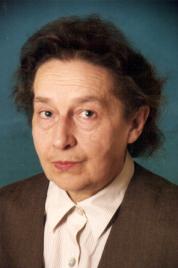 |
 |
Doctor of Physics and Mathematics(1991),
Professor(1993).
Head of the laboratory of Magnetic Semiconductors.
Reseach interests:
magnetic semiconductors, spin glasses, chalcogenide spinels, manganites, magnetic two-phase state.
Number of publications: more than 200.
|
Main results of science activity:
Theory foretold, that in magnetic semiconductors the special magnetic impurity states take place. For example in magnetic semiconductors with a red shift of the bottom of the coductive band with the temperature decrease the charge carriers self-trap near impurities and produce ferromagnetic (F) microregions (ferrons) because of energy gain in the intraband s-d exchange. In antiferromagnetic (AF) semiconductors the ferrons can exist leading off T = 0 and in F semiconductors the ones can present in vicinity of Curie point. In F semiconductors with the blue shift, on the contrary, it is profitable the formation of the microregions with destroyed F ordering (antiferrons) because of energy gain in the interband s-d exchange.
The experimental proofs of ferron existence in some compositions of magnetosemiconductive chalcospinels and manganites were received by Koroleva group. For example, with the help of ferrons the next experimental facts in the crystals of classical F semiconductors CdCr2Se4 and HgCr2Se4, doped with In or Ga, were explained:
- a giant maximum of electroresistivity slightly higher the Curie point, that is shifted toward high temperatures under a magnetic field;
- a giant negative magnetiresistance (MR) at Curie point and a large positive MR at higher temperatures which are accompanied with jumps in the magnetization-vs-field curves;
- a giant maximum of a photoresistivity in Curie point with no maximum of a dark resistivity in the crystals CdCr2Se4, slighly doped with Ga;
- a low-temperature metal-insulator transition in the crystals CdCr2Se4, heavily doped with In or Ga.
The experimental proofs of mentioned above magnetic two-phase state in manganite were received too. So it is observed that for insulating Eu1-xAxMnO3 (A = Ca, Sr; x = 0, 0.3) ceramics:
- a magnetization M depends on the cooling conditions up to maximal measuring field H = 45 kOe;
- the temperature TN of the initial susceptibility maximum is independent of magnetic field frequency;
- the maximal value of M is less than for a sample with full F ordering, namely 75% from latter at 45 kOe;
- magnetization isotherms at T < TN are a superposition of a linear part, characteristic for AF, and a small spontaneous magnetization;
- an electrical resistivity r maximum (rmax ~ 108 Ohm.cm) is observed near TN which decreases in a 140 kOe magnetic field by 104 times (colossal magnetoresistance), and the temperature of the maximum increases twice;
- in compositions with x = 0.3 the paramagnetic Curie point q is much higher than for the composition with x = 0: q = 110 K (A = Ca), 175 K (A = Sr), and - 100 K (x = 0);
and for La1-xSrxMnO3 single crystals:
- for conductive sample with x = 0.3 the volume magnetostriction (w = l|| + 2l^) is negative and the |w|(T) curves go through maximum at Curie point TC; at T > TC thermal expansion Dl/l exceeds linear thermal expansion;
- for semiconductive sample with x = 0.1, w is negative at T < TC and |w| ® 0 at T ~ TC and its Dl/l is linear at T і TC.
The new compositions of the magnetic semiconductors with TC і 300 K were found. It is solid solutions of chalcospinels: CuCr2S4-xSex (0.5ЈxЈ1.5), Cu1-xMnxCr2S4 et al. In the first system antiferrons take place. The composition with record Faraday rotation at the room temperature was found.
A new class of semiconductive spin glasses was found. This is a solid solutions systems: xCuCr2S4-(1-x)Ga2/3Cr2S4, xCuCr2S4-(1-x)Cu1/2Me1/2Cr2S4 (Me=In, Ga) and xCuCr2S4-(1-x)Cu2/3Ge1/3Cr2S4. It differs from the known spin glasses by the fact that the Cr3+ magnetic ions are arranged regularly in the lattice, but the exchange interactions between them are alternating ones, associated with the effect on the exchange both of diamagnetic ions with various valences and of vacancies of the tetrahedral sublattice.
Scientific direction developed by Koroleva: the investigation of peculiarities of magnetic ordering and concomitant electrical, galvanomagnetic, optical, magnetoelastic effects, due by strong s-d exchange, in magnetic semiconductors and spin glasses.
|
Several Publications:
- K.P. Belov, L.I. Koroleva, S.D. Batorova "Zone structure and anomalies of photoconductivity, electrical resistivity and magnetoresistance of Cd1-xGaxCr2Se4 composition", JETP, v.70, No 1, p. 141-148, 1976.
- L.I. Koroleva, E.L. Nagaev, N.A. Tsvetkova "Destruction of the spin glass state by indirect exchange via conduction electrons in xCuCr2S4-(1-x)Ga2/3Cr2S4 solid-solution system", Sov. Phys. JETP, v.52, No 2, p. 303-305, 1980
- L.I. Koroleva, T.V. Virovets, A.I. Abramovich, Ya.A. Kessler " New semiconductor spin glass Cu2/3Ge1/3Cr2S4. Comparison of magnetic and electrical properties of the spin glasses Cu0.5In0.5Cr2S4 and Cu2/3Ge1/3Cr2S4", J. Magn. & Magn. Mater., v. 115, No 4, p. 311-323, 1992.
- L.I. Koroleva "Antiferron states of charge carriers in the ferromagnetic semiconductors CuCr2S4-xSex (0.5ЈxЈ1.5) with Curie points above room temperature", JETP, 79, No 1, p. 153-162, 1994.
- A.I. Abramovich, R.V. Demin, L.I. Koroleva, A.V. Michurin, A.I. Smirnitskaya "Magnetically two-phase state in Eu1-xAxMnO3 (A=Ca, Sr)", JETP Letters, v. 69, No 5, p. 404-410, 1999.
|
ПРИМЕЧАНИЯ
|
|
|
 |